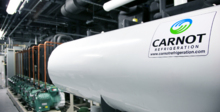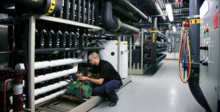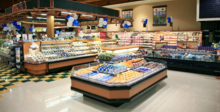Commercial / Supermarkets
Supermarket 40 000 Sq. Ft.
Introduction
For the past years, Carnot’s services have been retained by a major wholesaler and retailer in Canada in order to develop an alternative to the conventional refrigerated systems available on the market that were inefficient, had a high energy consumption and high maintenance costs. The goal to be achieved, was to provide a sustainable and reliable solution that would be cost e!cient in regard of initial cost (equipment and installation) as well as operating cost (energy, maintenance, gas replacement, insurance).
About the System
A supermarket (part of the second largest banner in Canada) in the north of Montreal, which opened in April 2011, occupies a total area of 40 866 ft2 (3 797 m2). The sales area of 30 488 ft2 (2 832 m2) o"ers 744 ft (227 m) long of refrigerated cases (85 MT cases) and 305 ft (93 m) long of freezers (40 BT cases). The supermarket also has a heat recovery system and intensive reclaiming of waste heat from the refrigeration units. That recovery system #lls almost all the heating needs of the supermarket. A pre-heating water loop is also installed in the supermarket.
Defrosting modes
Because it does not add any heat to the system, the technology that we have developed in previous commercial and industrial projects, others the great benefit of ensuring the stability for display case temperature, in contrast to some systems that can generate high temperature in display cases. Using our system, we have often observed that the temperature only rises from 4°C (39°F) to 5°C (41°F).
In the low temperature defrost process for refrigerated cases and freezer rooms, Carnot Refrigeration technology uses an electronic expansion valve that expands or contracts in real time to provide exactly the right amount of heat needed by each case to melt the ice. Low pressure gas is used (about 440 to 500 psig) to defrost the refrigerated cases and the evaporators of the freezer rooms.
During the defrost cycle, the same lines are used for the refrigeration cycle. In refrigeration mode, liquid CO2 is directed to the display cases through an oversized line. In defrost mode, the hot gas is directed straight to the display cases line using the liquid line.
To sum up, the biggest advantage of the hot gas defrost in CO2 refrigeration systems is the stability and the homogeneity of the temperature levels in display cases, freezer and preparation rooms.
Conclusion
Nowadays, transcritical CO2 refrigeration technology is a proven technology in Canada. The systems installed by Carnot Refrigeration in various supermarkets, is evidence of this. In fact, the GHG emissions are lower than those from a conventional supermarket of the same size in Canada. These gains are attributable to the reduction in synthetic refrigerant charges and the decrease of the total energy consumption (-10%). In addition, the heating of the sales area is entirely provided by the heat recovery.The interesting part about the new systems is that CO2 as refrigerant is used both in connection with mid temperature and low temperature.
After several successful transcritical CO2 refrigeration system installations in many supermarkets across Canada, the various solutions developed by Carnot are now available for all retailers that are operating in North America. Carnot can also help the retailers to smoothly introduce this new technology and manage the teams that will be faced with the technology change.







